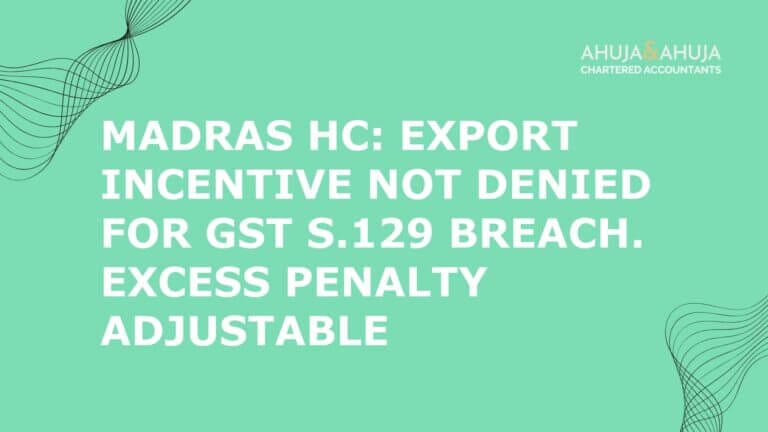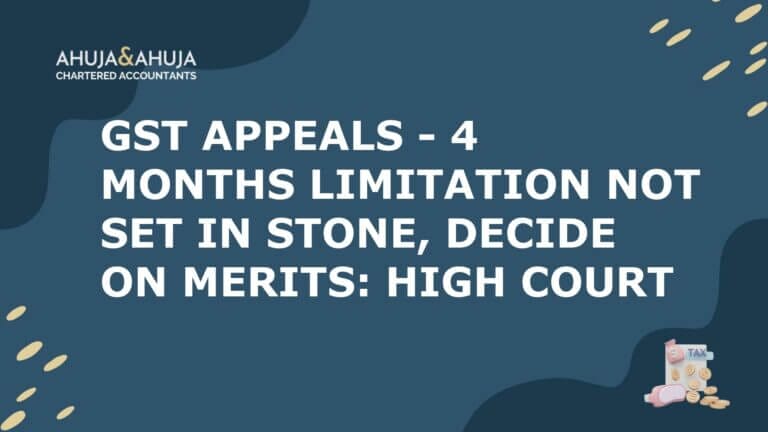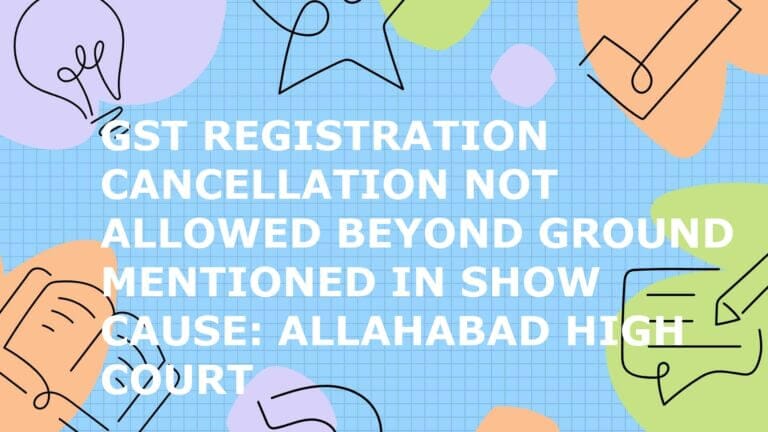Supreme Court Allows GST Return Rectification Beyond Due Dates: Key Takeaways for Businesses
In a landmark move, the Supreme Court of India has opened the door for businesses to rectify errors in their GST returns even after the statutory deadlines have lapsed. This judgment marks a significant shift in the compliance landscape, offering much-needed relief to businesses, Chartered Accountants (CAs), and compliance professionals who have long grappled with the rigidity of GST return timelines.
This article decodes the Supreme Court’s legal reasoning, the precedent it sets, and—most importantly—the practical implications for businesses and professionals. We’ll focus on actionable insights, the Court’s stance on bonafide (genuine, honest) errors, the directive to the Central Board of Indirect Taxes and Customs (CBIC) to revisit timelines, and the steps you should take if you discover an error in your GST filings. Lengthy case facts are skipped; instead, we zero in on what matters for your compliance and peace of mind.
Supreme Court’s Legal Reasoning: Break from Past Approaches
A. Statutory Framework and Past Rigidity
- Section 37(3) & Section 39(9) of the CGST Act: These sections set strict deadlines for rectifying errors in GST returns—typically, corrections must be made by 30th November following the end of the relevant financial year.
- Previous Approach: Most tax authorities and some High Courts interpreted these deadlines strictly, denying rectification requests made after the cut-off, even for honest mistakes. This led to hardship, especially when errors were discovered only after the deadline—often when a purchaser was denied Input Tax Credit (ITC).
B. Supreme Court’s Rationale: A Purposive, Business-Friendly Interpretation
- Right to Rectification = Right to Do Business: The Supreme Court held that the ability to correct clerical or arithmetical errors is an essential part of conducting business. Denying this right, especially when there is no loss to the revenue, is unjust.
- Bonafide Errors Deserve Relief: The Court distinguished between genuine, inadvertent mistakes and willful misstatements or fraud. Only the former are eligible for rectification.
- No Penalty Without Revenue Loss: If the error does not result in a loss to the exchequer, harsh penalties or denial of rectification are unwarranted.
- Citizen-Centric Statutory Interpretation: The Court adopted a purposive approach, focusing on the intent of the law and the realities of digital compliance, rather than a narrow, literal reading.
C. Clarification of Precedent
- Bombay High Court’s Progressive View: The Supreme Court aligned with the Bombay High Court’s stance, which recognized the need for error tolerance in a digital, evolving GST regime.
- Disapproval of Restrictive Readings: The Court expressly noted that earlier High Court decisions (like Bar Code India and Yokohama India) that took a stricter view do not lay down good law on this point.
Scope of Relief: Who Can Rectify, When, and for What
A. Applicability Limited to Bonafide Errors
- Definition: Only inadvertent, non-fraudulent, honest mistakes are covered. For example, entering the wrong GSTIN, putting data in the wrong column, or similar clerical slips.
- Exclusions: Willful misstatements, fraud, or errors intended to evade tax are not protected.
B. Evidence of No Revenue Loss
- Key Condition: Rectification is allowed only if it does not result in a loss to the government. For instance, if a purchaser is denied ITC even though the supplier has paid the tax, rectification should be permitted.
- Illustrative Scenarios:
- Supplier entered the wrong GSTIN, so purchaser’s ITC is blocked, but tax is already paid.
- Data entered in the wrong field, causing mismatch but not affecting tax liability.
C. Generalization and Boundaries
- Not a Blanket Permission: Each case must demonstrate the nature of the error and the absence of mala fide (bad faith) intent.
- Departmental Scrutiny: Authorities may still examine whether the error is truly bonafide and whether revenue is unaffected.
Action Points: Immediate Steps for Businesses and CAs Upon Error Discovery
A. Internal Review
- Audit Past Filings: Systematically review previous GST returns for possible bonafide errors. Businesses operating in Delhi and Chandigarh can leverage local expertise to conduct these comprehensive audits efficiently.
- Document Discovery: Record when and how the error was found, and the context.
B. Preparation of Rectification Request
- Gather Evidence: Collect supporting documents—such as invoices, reconciliation statements, and proof of tax payment.
- Draft Application: Clearly state the nature of the error, demonstrate that it is bonafide, and confirm that no revenue loss has occurred.
C. Departmental Coordination
- Portal Access: Apply for rectification through the GST portal (GSTR-1/GSTR-3B). If the portal does not allow, request manual rectification as per the Court’s mandate.
- Follow Protocols: Adhere to departmental procedures, respond to notices, and attend hearings if required.
Impact of Supreme Court’s Directive to CBIC: Future of GST Return Correction
A. Central Mandate: Revisiting Timelines and Provisions
- CBIC Must Act: The Supreme Court has directed the CBIC to set more realistic, practical timelines for correcting bonafide errors.
- Potential Reforms: Expect extended correction windows and more flexible mechanisms for error reporting.
B. Regulatory Ripple Effect
- GSTN Portal Updates: The GSTN portal may be upgraded to allow late rectifications.
- New Circulars Expected: CBIC is likely to issue fresh guidance on timelines, documentation, and dispute resolution.
- Codification of Criteria: Definitions of ‘bonafide error’ and ‘no revenue loss’ may be formally included in future rules.
Direct Implications for Purchasers Denied Input Tax Credit (ITC)
A. Purchaser Relief: Prevention of Double Taxation
- No Fault, No Penalty: The Court recognized that denying ITC to a purchaser who has paid tax—just because of a supplier’s error—is unjust and leads to double taxation.
B. Pathways for Recourse
- Rectification Requests: Purchasers can now seek rectification through their suppliers or directly with the department, referencing the Supreme Court’s directive.
- Reduced Disputes: This should lead to fewer ITC disputes and prevent cascading tax effects, a concern also discussed in our blog on GST Sellers Beware! Buyer can Recover Penalties if ITC Denied Due to Seller’s Fault.
Software/Portal Constraints: Legal and Procedural Workarounds
A. Court’s Rejection of ‘Software Limitation’ Defense
- No Excuse: The Court made it clear—software limitations cannot be used to deny legal rights. Compliance systems must be updated to reflect the law.
B. Manual Rectification Option
- If Portal Fails, Go Manual: If the GST portal does not permit rectification, businesses can submit written/manual applications, which must now be accepted and processed by the department.
- Best Practices: Keep records of all manual applications and follow up regularly.
Documentation and Demonstrating Bona Fide Error & No Revenue Loss
A. Required Evidence
- Audit Trail: Maintain clear records—supporting entries, communications, and proof of tax payment.
- Context Statements: Prepare statements explaining the error, its discovery, and the absence of fraudulent intent.
B. Proactive Audit-Readiness
- Error Review Logs: Keep logs of error reviews for internal and external audits.
- Institutionalize Protocols: Set up documentation procedures for future cases.
Precedential Value and Ongoing Litigation
A. Supreme Court’s Ruling as Law of the Land
- Binding Effect: The judgment is binding on all lower courts and tax authorities.
- Impact on Pending Cases: Many ongoing disputes may now be resolved quickly, with departmental objections likely to be withdrawn.
B. Future Case Scenarios
- Influence on Similar Cases: The ruling will guide future cases, especially where there is no revenue loss and the error is genuine.
- Scope for Further Review: The Supreme Court may revisit certain precedents in future, but the current direction is clear.
Risks, Conditions, and Ongoing Departmental Objections
A. Not a Free Pass
- Scrutiny Remains: Departments will still check if the error is truly bonafide and revenue-neutral.
- Possible Hearings: Notices and personal hearings may be required.
B. Potential Pitfalls
- Misclassification Risks: Errors wrongly claimed as bonafide may be rejected.
- Incomplete Documentation: Lack of evidence can lead to denial.
- Delimitations: Willful fraud, revenue-reducing adjustments, or systemic glitches may still face resistance.
Updating Internal Controls and Professional Advisory
A. Guidance for Compliance Teams and CAs
- Update SOPs: Revise standard operating procedures for GST returns, error detection, and rectification.
- Educate Staff and Clients: Share the Supreme Court’s rationale and new procedures. Firms specializing in GST consultancy services can assist in these updates.
B. Monitoring CBIC Policy Response
- Stay Alert: Set up alerts for new CBIC/GSTN updates.
- Adaptive Workflows: Be ready to integrate regulatory changes into your compliance processes.
Final Words
The Supreme Court’s judgment is a pragmatic, business-sensitive step that recognizes the realities of digital compliance and human error. Businesses and professionals should act swiftly to review past filings, document errors, and seek rectification where eligible. Remember, this relief is limited to bonafide, non-revenue-impacting cases—so vigilance, documentation, and responsiveness to evolving rules are key. Stay tuned for CBIC’s policy updates and keep your compliance systems ready for change.
Key Takeaway:
GST compliance is evolving—embrace the opportunity to correct honest mistakes, but do so with care, evidence, and professional diligence. If you need expert support in managing your GST compliance in Gurgaon or Noida, consulting a professional CA firm can be invaluable.
Disclaimer
The materials provided herein are solely for educational and informational purposes. No attorney/professional-client relationship is created when you access or use the site or the materials. The information presented on this site does not constitute legal or professional advice and should not be relied upon for such purposes or used as a substitute for professional or legal advice.







